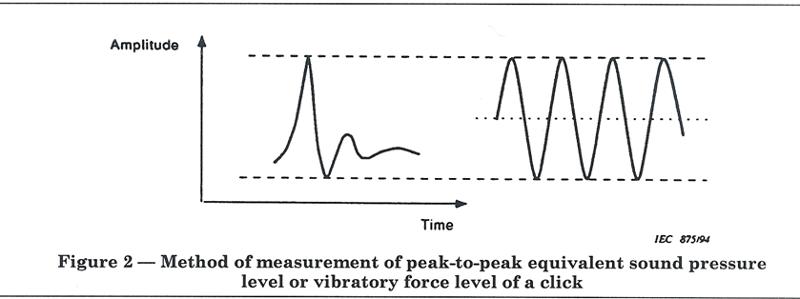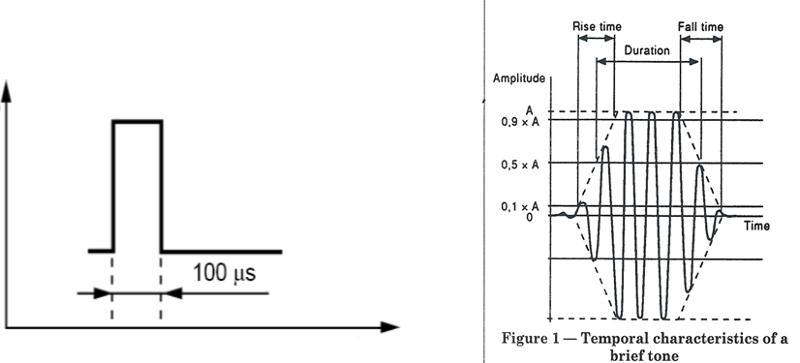Short Duration Signals
In this section we will look at how we can calibrate signals of short duration. The basic issues is that Sound Level meters are not able to accurately capture and measure transient signals such as those used in OAEs or ABRs etc. Such signals are short duration but repetitive and thus the SLM will also capture persiods of silence between the stimuli which will then be included within the averaging period of the SLM.
Peak-equivalent SPL (dB pe SPL)
To get round this problem we need a signal that is comparable to the transient that we are able to measure on the SLM. The signal we use is a sinusoid, and we equate it to the transient signal's peak-to-peak amplitude. That is, we set the sinusoid to have the same peak-to-peak amplitude as the transient signal and then measure the dB SPL of the sinusoid. So for example, if our we set the sinusoid to be the same amplitude as a click and the sinusoid measures 100 dB SPL then we can say the click has a level of 100 dB pe SPL. For a click stimulus we would compare it with a sinusoid of 1000 Hz, whereas for a tone-pip we would set the sinusoid to the same frequency as the tone-pip.
The figure below shows the basic principle.
Figure 11 - illustration of peak equivalence

Figure 11 - illustration of what is meant by peak-equivalence. The basic principle is that the transient signal is captured on an oscilloscope and then a pure-tone is then produced with the same peak-to-peak amplitude and the dB SPL of the pure-tone is then measured on an SLM.
Procedure
The basic measurement setup is the same for PTA calibration, sound from the ABR (or whaterver) machine is played through the headphones into the appropiate coupler connected to a sound level meter. However, as we also need to capture the waveform we take the electrical output from the SLM and feed it into an oscilloscope so that we can capture the waveform. Once the transient waveform is captured on the oscilloscope we measure the peak-to-peak voltage on the oscilloscope. We then play a sinusoid of the appropiate frequency and adjust the level of the sinusoid until it gives the same peak-to-peak amplitude on the oscilloscope. No that the two signals are equated in amplitude we can measure the dB SPL of the sinusoid on the SLM to get the dB pe SPL of the transient signal.
RETSPL Values
Whilst pure-tone signals are easily defined, transient signals can be of varying duration and repetition rate, and for tone-pips the rise and fall time can also vary. In order to try to standardise tehse signals BS EN 60645-3 has been produced which specifies waveform shapes and durations for such signals. For example the standard specifies a click of 100μS duration (for further details see standard).
Figure 12 - examples of 'standard transient signals'

Figure 12 - Left: a 'standard click' which has a rectangular electrical pulse going into the transducer with a duration of 100μS (use of a shorter or longer duration will result in different amounts of energy and hence different threshold. Right: a 'standard tone-pip' which has a specific shape and duration (defined in terms of the number of cycles of the waveform in the rise, flar, and fall reagions of the waveform), again, difference from this standard will alter the measured thresholds and thus the RETSPL values will not be valid.
If the stimulus used conforms to this standard then BS EN ISO 389-6:2007 can also be used to provide RETSPL values for these signals. However, it is important to understand that these RETSPL valuse only apply to specific conditions. That is, they are transducer and coupler specific and are for specific durations of stimulus and repetition rates. This is because threshold for these stimuli varies with repetition rates. The following table is an extract from this standard.
Table 5 - peRETSPL values for standard clicks

Table 5 - peRETSPL values for standard clicks presented at 20Hz for a duration of 1s. Thus for ER-3A insert earphones 0 dB HL will correspond to 35.5 dB peSPL.
The standard also gives RETSPL values for tone-pips. It is important to note that these peRETSPL values are for behavioural thresholds. Because of this, care must be taken in interpreting other measures (e.g. ABR thresholds) specified in dB HL. It is also important to note that changes in the repetition rate of the clicks will affect the threshold values (higher rates contain more energy and thus produce lower thresholds) - the standard gives correction factors for different repetition rates between 10-100Hz.
dB nHL
If the stimulus being used does not conform to BS EN 60645-3 then it is important to obtain local 'normal hearing' standards. For this, the basic principle is that ABR (or cortical etc) thresholds are measured 30 or so normal hearing young adults and the median electrophysiological threshold is then taken as being "normal" (i.e. 0 dB nHL) all other measurements are then expressed relative to this.
References
BS EN 60645-3:2020 Electroacoustics. Audiometric equipment. Test signals of short duration
BS EN ISO 389-6:2007 Acoustics. Reference zero for the calibration of audiometric equipment. Reference threshold of hearing for test signals of short duration